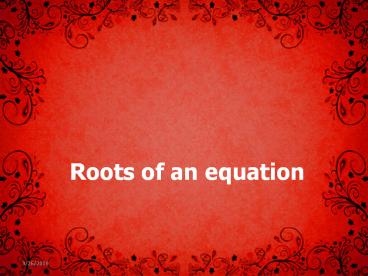Bisection method - PowerPoint PPT Presentation
Title:
Bisection method
Description:
Mathematics-IV for BPUT students. – PowerPoint PPT presentation
Number of Views:799
Title: Bisection method
1
Roots of an equation
2
Introduction
Polynomial-
Equation-
An mathematical expression equating to zero is
called an equation
Ex- 3x250 sinx-10 ex-10 etc
Algebraic equation-
An polynomial f(x)0 is called an algebraic
equation of degree n
Ex- x6x250 x1070
3
Continue..
Transcendental equation-
An equation which contains functions like
trigonometry, exponential, logarithm, hyperbolic
functions etc are called transcendental equation.
Ex- x-sinx0 lnx-5x0 ex5x0 sinxlnxx2c etc
Root of an Equation-
The value of x for which the given equation
f(x)0 satisfies is called root of that equation.
Ex- x-3 is the root of equation x25x60
X2 is the root of equation x2-40. X2
is the root of x5-320 etc
4
Rolls theorem-
- If f(x) is continuous in a closed interval a x
b and f(a), f(b) are of opposite signs(i.e. if
f(a) is ve or ve , then f(b) is ve or ve),
then there exist at least one number c such
that a c b, f(c)0.(i.e. an root c exists)
5
Methods for calculating roots-
There are various methods for finding the roots
of a given equation. Some of them are
- Bisection method.
- The False-position method (Regula-falsi Method)
- Fixed point iteration.
- Newton- Raphson method.
- Secant method
- Modified secant method.
- Mullers method.
6
Bisection Method-
- The Bisection Method is a successive
approximation method that narrows down an
interval that contains a root of the function
f(x) - The Bisection Method is given an initial interval
a..b that contains a root (We can use the
property sign of f(a) ? sign of f(b) to find such
an initial interval) - The Bisection Method will cut the interval into 2
halves and check which half interval contains a
root of the function - The Bisection Method will keep cut the interval
in halves until the resulting interval is
extremely small - The root is then approximately equal to any value
in the final (very small) interval.
7
Bisection method Algorithm to find root in a,b
2) Find the value f(xr). check if f(xr)0, then
xr is the desired root and stop the iterative
process. Otherwise go to next step
3) Check if f (a).f(xr)lt0, then set bxr. if
f(xr).f(b)lt0, then set axr
4) Go to step-1 with new interval a,b . Repeat
the process up to specified no. of iterations or
a pre specified criteria es will meet
8
Example
Ans-
Now we need to find an closed interval a,b such
that f(a).f(b)lt0
So we will take 0,1 as the our required interval
9
Continue
1st approximation-
Then the new interval is a,b0,0.5
10
Continue.
2nd approximation-
Thus a,b0.25,0.5
11
Continue
3rd approximation-
a0.25 f(0.25)-1.671875lt0 and b0.5
f(0.5)0.375gt0
Thus a,b0.375,0.5
12
Continue
4th approximation-
a0.375 f(0.375)-0.1894lt0
b0.5 f(0.5)0.375gt0
Thus a,b0.375,0.4375
13
Continue..
5th approximation-
a0.375 f(0.375)-0.1894lt0 and b0.4375
f(0.4375)0.0866gt0
so the approximation process is terminated
The required approximation root is x0.40625
14
Summary of the problem
a b f(a) f(b) xr f(xr) ?a
0 1 -2 4 0.5 0.375gt0 ------
0 0.5 -2 0.375 0.25 -0.671875lt0 100
0.25 0.5 -1.671875 0.375 0.375 -0.1894lt0 33.3
0.375 0.5 -0.1894 0.375 0.4375 0.0866gt0 14.28
0.375 0.4375 -0.1894 0.0866 0.40625 -0.0524lt0 7.69
15
Assignment
1) Find the real root of f(x)x3-9x10. Correct
to two significant figures by bisection method.
2) Determine the real root of f(x)-0.5x22.5x4.
5. use three iterations of bisection method. Let
xl5,xu10. Compute both approximate percent
relative and true percent relative error for each
case.
16
Thank You ALL
- Presented by
- Boina Anil Kumar
- Asst.Prof in Mathematics
- MITS, Rayagada.
- Odisha, India
- E-mail anil.anisrav_at_gmail.com
- Visit at http//www.mits.edu.in/academics.phpfac
ulty_BSH-tab
17
Thank You ALL































